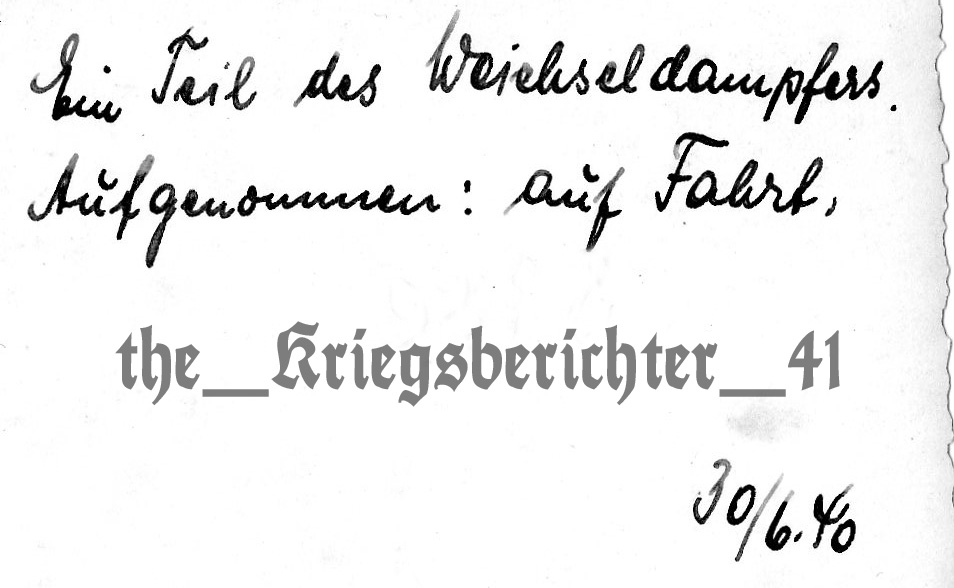Journey on a steamboat on the River Weichsel 30/6/40
- The Kriegsberichter 41
- Jun 30, 2022
- 4 min read
Part of The KB41 Collection On This Day Series!
The photograph here show Heer Jnfanterie (Infantry) enjoying some leisure time on a steamboat ride along the River Weichselfull on 30th June 1940.
The photograph details a large steamboat to which is filled with many smartly dressed Heer Infantiers seen wearing an mixture of M36 Tunics and M40 tunics. The M36 Tunic being more common, this clearly seen from the bottle green collars. The M40 tunic being introduced n 1938, taking a while to be adopted by many who are still seen wearing the M36 tunic here in 1940. As appose the M36, The M40 tunic was worn throughout the war as it slowly replaced the M36 tunic. The Heer Infanteries seen here are onboard a Steamboat, the reverse of the photographs details the word "Vistula" which is located in Poland, (written in German as Weichselfull). The river on which the steamboat is photographed is just outside Warsaw, the river itself was one of the regions within Poland that saw the Wehrmacht forces in conflict against the Polish army of Pomerania. The main fighting was conducted around the mouth of the River Vistula.
It is also notable about the River Vistula, or more particular its surrounds, that Konzentrationslager-Auschwitz (Auschwitz Concentration camp) is located at the merging point of the rivers Vistula and Soła, near to the town of Oświęcim, 50km southwest of Kraków, second city of Poland. The main camp (die Stammlager) was a former World War I camp for transient workers and later a Horse Breaking Yard, and stables of a Polish Army Cavalry barracks. Auschwitz I (Stammlager) would remain the administrative headquarters of the camp complex. the site was first suggested in February 1940 as a quarantine camp for Polish prisoners by Arpad Wigand, the inspector of the Sicherheitspolizei (security police) and deputy of Erich von dem Bach-Zelewski, the Higher SS and Police Leader for Silesia
It was later to transpire that the burnt remains of the murdered victims of the camp would be dumped and disposed of into the river. The river also see the Wehrmacht forces pushed back as apart of the Vistula–Oder offensive in early 1945, the Wehrmacht was pushed back to the Oder river and then intro Germany.
The photograph here was taken on the 30th June 1940; it tells us that this was taken after the the invasion of Poland ,which took place on the 1st September 1939, and also ain the later stages of the "mopping up" in France (which these men appear to have been spared by the lack of combat decorations, and their presence in the East).
The photograph being taken in a German occupied part of Poland, these Heer Infanterymen enjoy the leisure time along this steamboat ride, likely taking in the sights of the battleground they or their kameraden had fought over; with the relaxing soldiers seen below and on the upper decks. The steamboat can be seen with a chimney surrounded by the upper deck. The upper deck, detailed with rubber safety rings and a large quantity of alcohol, particularly Weißbier and Pilsner, seen stored and stacked in crates towards the right. A few officers can be seen above deck too, the furthest right seen with a map case and cross strap, likely a Der Speiß, whilst below this can be seen the the somnolent manschaften, notably two seen standing for the photographer, who is likely a friend whom they wished to photograph them on their steamboat cruise. The man on the left can be seen with a SA-Sportabzeichen (SA sports award) seen here in Bronze grade, whereas, in the lower left foreground we can spot another of their comrades with an award in the form of the Sudetenland feldspange bar in wear.
An atmosphere can be felt in this photograph, that of a joyful time and some cherished feelings in this time. The party would later commence with the beer seen stacked above and likely signing and laughter. Some are seen smoking which can be seen on the left, the relaxed atmosphere away from combat shows these infanteries enjoying this moment. It’s recorded on the back to mark the moment “Being a part of a Journey on a steamboat on the River Weichsel – 30/6/40”. Marking a meaningful day and memorable one by recording the event on the reverse. The photograph being a meaningful one to the Infanterymen seen in the centre. This crisp early war photograph full of soldiers enjoying occupied Poland, they are yet to see what the rest of the war has for them. Tougher times likely lay ahead for them, and undoubtedly, few of the men shown would survive the planned invasion of the Soviet Union.
Whilst feelings now may vary, it is important to remember that for each man, there was, and likely still is, a family, and in this initial period of WW2, each man would likely have still believed the "Regime" in its presentation that "After Poland, and now we have routed France, the British will sue for peace". We know that WW2 would last until August 1945, a further 5 years.
Lest we forget.






what model field caps are they wearing?
what a post! just finished reading the context and it's intresting that you talk about all the little details such as the SA sports award etc. It is also intresting to see the happy side of the German Wehrmacht and that it wasnt all about war and stuff, seems like theyre havin a good time. I would wonder tho how many actually made it to the end of the war, I would imagine very little espicially hearing that many wouldnt survive the invasion of the soviet union. nonetheless great post!